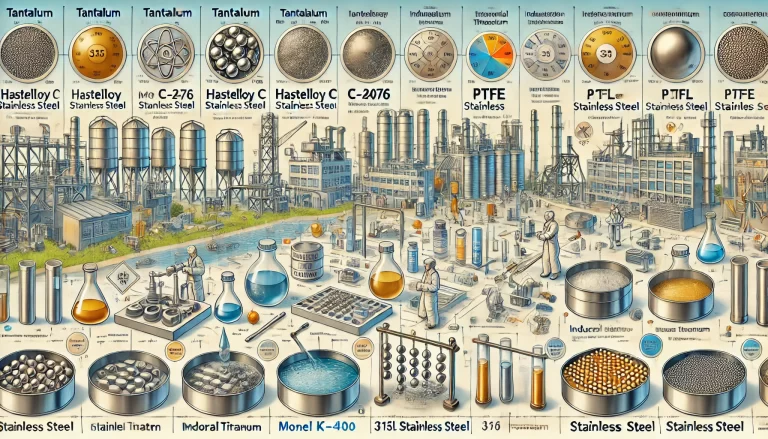Selecting materials with suitable corrosion resistance is critical for ensuring the durability and performance of industrial instruments. This article provides a detailed comparison of commonly used materials and their resistance to various corrosive environments.
1. Tantalum (Ta)
- Key Features: Tantalum exhibits excellent corrosion resistance. It is particularly resistant to hydrochloric acid and aqua regia, making it suitable for highly aggressive environments.
- Limitations: Not resistant to hydrofluoric acid or strong alkaline solutions.
2. Hastelloy C-276 (HC)
- Key Features: This alloy offers outstanding resistance in both oxidizing and reducing environments. It performs well in contact with dry chlorine gas, nitric acid (up to 50°C), phosphoric acid, acetic acid, and seawater.
- Applications: Suitable for processes involving chlorides, caustic soda, and organic acids. It can be used conditionally with hydrochloric and sulfuric acids.
- Limitations: Shows some tendency to intergranular corrosion.

3. Monel K-400 (M)
- Key Features: Monel excels in resisting reducing agents. It is particularly stable in hydrofluoric acid and alkaline solutions, as well as in dry chlorine gas and organic acids.
- Limitations: Not suitable for hydrochloric acid or moist hydrogen sulfide vapor environments.
4. Industrial-Grade Titanium (Ti)
- Key Features: Titanium offers excellent resistance to seawater, chlorides, and oxidizing acids such as nitric acid. It also performs well in organic acids and alkaline environments.
- Limitations: Poor resistance to pure reducing acids (e.g., hydrochloric acid and sulfuric acid), dry chlorine gas, and titanium tetrachloride.
5. 316L Stainless Steel (316L S.S.)
- Key Features: 316L is highly resistant to a variety of corrosive agents, including steam, hot alkaline solutions, boiling phosphoric acid, hydrogen sulfide, acetic acid, formic acid, and sulfurous acid. It is particularly effective against nitric acid across all temperatures and concentrations.
- Limitations: Its resistance to sulfuric acid, moist chlorine gas, and certain chloride environments is less robust.
6. PTFE-Lined 316L Stainless Steel (F4)
- Key Features: This composite material exhibits near-universal chemical stability, making it resistant to nearly all media except for high-temperature fluorine gas and high-velocity liquid fluorine.
- Applications: Ideal for extreme environments where chemical stability is a priority.

7. Gold-Plated 316L Stainless Steel (Au)
- Key Features: Gold plating significantly enhances corrosion resistance, especially against acids, bases, and salts. Its performance is similar to tantalum, but it has lower resistance to aqua regia and halogens.
- Applications: Recommended for environments involving high-temperature hydrogen chloride and hydrogen gas.
Recommendations for Material Selection
When selecting materials for industrial instruments, consider the specific corrosive agents, temperature, and environmental conditions. For example:
- Use Tantalum or Gold-Plated Steel for environments with strong acids.
- Opt for Hastelloy C-276 in versatile applications with both oxidizing and reducing agents.
- Choose PTFE-Lined Stainless Steel for environments requiring near-universal chemical stability.
Table: Quick Comparison of Corrosion Resistance
| Material | Best For | Not Suitable For |
|---|---|---|
| Tantalum (Ta) | Hydrochloric acid, aqua regia | Hydrofluoric acid, strong alkaline |
| Hastelloy C-276 (HC) | Oxidizing and reducing media | Limited intergranular corrosion |
| Monel K-400 (M) | Hydrofluoric acid, alkalines | Hydrochloric acid, moist H₂S vapor |
| Industrial Titanium (Ti) | Chlorides, nitric acid | Pure reducing acids, dry chlorine gas |
| 316L Stainless Steel | Nitric acid, organic acids | Sulfuric acid, moist chlorine |
| PTFE-Lined Steel (F4) | Almost all chemicals | High-temp fluorine, liquid fluorine |
| Gold-Plated Steel (Au) | High-temp HCl, hydrogen gas | Aqua regia, halogens |
